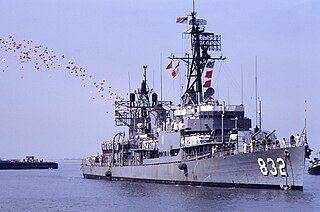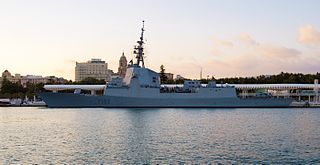
The Spanish Navy or officially, the Armada, is the maritime branch of the Spanish Armed Forces and one of the oldest active naval forces in the world. The Spanish Navy was responsible for a number of major historic achievements in navigation, the most famous being the discovery of America and the first global circumnavigation by Elcano. For several centuries, it played a crucial logistical role in the expansion and consolidation of the Spanish Empire, and defended a vast trade network across the Atlantic Ocean between the Americas and Europe, and the Manila Galleon across the Pacific Ocean between the Philippines and the Americas.

The Fleet Rehabilitation and Modernization (FRAM) program of the United States Navy extended the lives of World War II-era destroyers by shifting their mission from a surface attack role to that of a submarine hunter. The FRAM program also covered cruisers, aircraft carriers, submarines, amphibious ships, and auxiliaries. The United States Coast Guard also used this term in the 1980s for the modernization of its Hamilton-class cutters.

The Gearing class was a series of 98 destroyers built for the U.S. Navy during and shortly after World War II. The Gearing design was a minor modification of the Allen M. Sumner class, whereby the hull was lengthened by 14 ft (4.3 m) at amidships, which resulted in more fuel storage space and increased the operating range.

The Allen M. Sumner class was a group of 58 destroyers built by the United States during World War II. Another twelve ships were completed as destroyer minelayers. The class was named for Allen Melancthon Sumner, an officer in the United States Marine Corps. Often referred to as simply the Sumner, this class was distinguished from the previous Fletcher class by their twin 5-inch/38 caliber gun mounts, dual rudders, additional anti-aircraft weapons, and many other advancements. The Allen M. Sumner design was extended 14 feet (4.3 m) amidships to become the Gearing class, which was produced in larger numbers but did not see significant service in World War II.

Casto Secundino María Méndez Núñez was a Spanish naval officer. In 1866 during the Chincha Islands War between Spain, Peru and Chile, he was general commander of the Spanish fleet in the Pacific. As such, he bombarded and destroyed the port of Valparaiso, and fought the Battle of Callao Méndez Núñez was the first man to circumnavigate the world on an ironclad warship: "Enloricata navis quae primo terram circuivit".

USS Eugene A. Greene (DD/DDR-711) was a Gearing-class destroyer of the United States Navy, named for Ensign Eugene A. Greene (1921–1942), was posthumously awarded the Navy Cross for his heroism in the Battle of Midway.

Admiral Blas de Lezo y Olavarrieta was a Spanish navy officer best remembered for the Battle of Cartagena de Indias (1741) in the Viceroyalty of New Granada, where Spanish imperial forces under his command decisively defeated a large British invasion fleet under Admiral Edward Vernon.

USS Noa (DD-841) was a Gearing-class destroyer of the United States Navy, the second Navy ship named for midshipman Loveman Noa (1878–1901).

The Churruca class was a Spanish destroyer class built for the Spanish Navy based on a British design. Eighteen ships were built, with two being sold to Argentina and commonly referred to as the Cervantes class. The last two members of the class are sometimes referred to as a separate class, the Alava class.

Lepanto was a Churruca-class destroyer of the Spanish Republican Navy. She took part in the Spanish Civil War on the side of the government of the Second Spanish Republic. She was named after the Battle of Lepanto.

The Spanish Republican Navy was the naval arm of the Armed Forces of the Second Spanish Republic, the legally established government of Spain between 1931 and 1939.

The Chungbuk-class was a class of 7 destroyers, formerly the United States' Gearing-class destroyer, that were transferred to and commissioned by the Republic of Korea Navy. They entered service in 1972, with the last one being decommissioned in 2001.

The Lepanto class was a class of five destroyers of the Spanish Navy. They entered service in 1957, with the last one being decommissioned in 1988.

Blas de Lezo (F-103) is a Spanish Navy guided missile frigate of the Álvaro de Bazán class. This is the third ship class of air defense frigates in the Spanish Navy. It was named after the 18th century Spanish Admiral Blas de Lezo. The ship was built by Izar Shipbuilding in Ferrol, Spain and entered into service in 2004.

Cristóbal Colón is the fifth and last ship of the Álvaro de Bazán-class of air defence frigates entering service with the Spanish Navy. The ship is named after Christopher Columbus, the Genoese explorer that claimed the discovery of America in the name of the Crown of Castile. It is the most modern ship of the Spanish Navy.

The Oquendo-class destroyers was a class of three destroyers built for the Spanish Navy. The nine initially projected Oquendo-class destroyers were the most ambitious project fronted by the programs of naval construction of the post-war period in Spain; however, the adoption of Rateau/Bretagne propulsion system, being of a low reliability and high complexity, coupled with the limited capacity of the shipbuilding industry in Spain at the time, led to one of the largest investor fiascos of the Spanish Navy in the 20th century. These ships would be assigned the names and numbers of; D-41 Oquendo, D-42 Roger de Lauria, and D-43 Marqués de la Ensenada.
Almirante Miranda (AM) was a Churruca-class destroyer that fought in the Spanish Civil War on the Republican side and, after the war, joined the post-war Spanish Navy. She was named after Admiral Augusto Miranda y Godoy, a Spanish Minister of the Navy.
Spanish Civil War Republican ship classes is a list of ship classes used by the Spanish Republicans during the Spanish Civil War.
Audaz was a Spanish destroyer of the class of the same name that was built after the Second World War. Audaz was launched in 1951 and completed in 1953. The ship was modified to an anti-submarine escort in the 1960s, and was stricken in 1974.

















